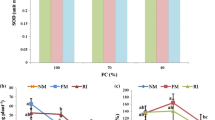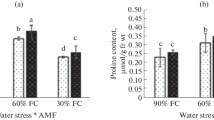Abstract
Application of mycorrhizal fungi and salicylic acid (SA) has been found very effective in reducing the adverse affects of drought. Our research examined interaction between seed treatment with 250 µM SA and two mycorrhizal fungi [Funeliformis mosseae (FM) and Rhizophagus intraradices (RI)] under different irrigation levels [100, 70, and 40 % of field capacity (FC)] on photosynthetic pigments, relative water content (RWC), proline content, leaf area (LA), dry weight (DW), phosphorus content, mycorrhizal colonization percentage (MCP) and mycorrhizal dependency (MD) in flaxseed plants during 160 days in 2010–2011. Drought stress reduced LA, plant P, DW, and RWC, but increased soil P, proline content, MCP, and MD, but had no marked effects on plant pigments. In mycorrhizal plants, chlorophyll, LA, RWC, MD, and MCP increased under drought and non-stress condition and RI was more effective than FM on these traits especially under severe drought. Salicylic acid application had positive effect only on MCP and P in the plant under 100 and 70 % FC, while reduced MD, MCP, and plant P at 40 % FC. Moreover, SA application increased LA, plant P, and RWC of non-mycorrhizal plants, but decreased these traits in mycorrhizal plants. In addition, there was antagonistic action between AM fungi and SA. SA may reduce positive effects of mycorrhizal fungi on flaxseed performances under both stress and non-stress conditions. The results suggested that AM inoculation may increase flaxseed growth under both stress and non-stress conditions, while SA application may reduce growth. Moreover, when SA application combines with AM inoculation flaxseed growth may decline suggesting that there may not be synergic effect between these treatments on flaxseed growth.
Similar content being viewed by others
Abbreviations
- AM:
-
Arbuscular mycorrhizal
- SA:
-
Salicylic acid
- FM:
-
Funeliformis mosseae
- RI:
-
Rhizophagus intraradices
- FC:
-
Field capacity
- RWC:
-
Relative water content
- LA:
-
Leaf area
- DW:
-
Dry weight
- MCP:
-
Mycorrhizal colonization percentage
- MD:
-
Mycorrhizal dependency
References
Abdel-Fattah GM, Asrar AWA (2012) Arbuscular mycorrhizal fungal application to improve growth and tolerance of wheat (Triticumaestivum L.) plants grown in saline soil. Acta Physiol Plant 34:267–277. doi:10.1007/s11738-011-0825-6
Arnon DI (1949) Copper enzyme in isolated chloroplast polyphenoloxidase in Beta vulgaris. Plant Physiol 24:1–15
Augé RM (2001) Water relations, drought and vesicular-arbuscular mycorrhizal symbiosis. Mycorrhiza 11:3–42
Baslam M, Goicoechea N (2012) Water deficit improved the capacity of arbuscular mycorrhizal fungi (AMF) for inducing the accumulation of antioxidant compounds in lettuce leaves. Mycorrhiza 22:347–359. doi:10.1007/s00572-011-0408-9
Bates LS, Waldren RP, Teare LD (1973) Rapid determination of free proline for water-stress studies. Plant Soil 39:205–207. doi:10.1007/bf00018060
Belkhadi A, HedijiH Abbes Z, Nouairi I, Barhoumi Z, ZarroukM Chaibi W, Djebali W (2010) Effects of exogenous salicylic acid pre-treatment on cadmium toxicity and leaf lipid content in Linumusitatissimum L. Ecotox Environ Safe 73:1004–1011. doi:10.1016/j.ecoenv.2010.03.009
Blilou I, Ocampo JA, Garcia-Garrido JM (1999) Resistance of pea roots to endomycorrhizal fungus or Rhizobium correlates with enhanced levels of endogenous salicylic acid. J Exp Bot 50:1663–1668. doi:10.1093/jxb/50.340.1663
Blilou I, Ocampo JA, Garcia-Garrido JM (2000) Induction of Ltp (lipid transfer protein) and Pal (phenylalanine ammonia-lyase) gene expression in rice roots colonized by the arbuscular mycorrhizal fungus Glomus mosseae. J Exp Bot 51:1969–1977. doi:10.1093/jexbot/51.353.1969
Busso CA, Bolletta AI (2008) Soil phosphorus concentration under the canopy of perennial grasses of different successional stages exposed to water stress. Commun Soil Sci Plant Anal 39:2768–2783. doi:10.1080/00103620802359001
Casa R, Russell G, Lo Cascio B, Rossini F (1999) Environmental effects on linseed (Linumusitatissimum L.) yield and growth of flax at different stand densities. Eur J Agron 11:267–278. doi:10.1016/S1161-0301(99)00037-4
Cekic OF, Unyayar S, Ortas I (2012) Effects of arbuscular mycorrhizal inoculation on biochemical parameters in Capsicum annuumL. (pepper) grown under long term salt stress. Turk J Bot 36:1–10. doi:10.3906/bot-1008-32
Eraslan F, Inal A, Pilbeam DJ, Gunes A (2008) Interactive effects of salicylic acid and silicon on oxidative damage and antioxidant activity in spinach (Spinaciaoleracea L. cv. Matador) grown under boron toxicity and salinity. Plant Growth Regul 55:207–219. doi:10.1007/s10725-008-9277-4
Farooq M, Wahid A, Kobayashi N, Fujita D, Basra SMA (2009) Plant drought stress: effects, mechanisms and management. Agron Sustain Dev 29:185–212. doi:10.1051/agro:2008021
Fu J, Huang B (2001) Involvement of antioxidants and lipid peroxidation in the adaptation of two cool-season grasses to localized drought stress. Environ Exp Bot 45:105–114
Gerdemann JW(1975) Vesicular arbuscular mycorrhizal. In: Torrey DG, Clarkson DTC (eds) The development and function of roots. Academic press, London, pp 575–591
Giovannetti M, Mosse B (1980) An evaluation of techniques formeasuringvesicular-arbuscular mycorrhizal infection in roots. New Phytol 84:489–500. doi:10.1111/j.1469-8137.1980.tb04556.x
Idrees M, Naeem M, Aftab T, Masroor M, Moinuddin AK (2011) Salicylic acid mitigates salinity stress by improving antioxidant defence system and enhances vincristine and vinblastine alkaloids production in periwinkle [Catharanthusroseus (L.) G. Don]. Acta Physiol Plant 33:987–999. doi:10.1007/s11738-010-0631-6
Iqbal M, Ashraf M, Jamil A, Shafiq URM (2006) Does seed priming inducechanges in the levels of some endogenous plant hormones in hexaploid wheat plant under saltstress. J Integrative Plant Biol 48:181–189. doi:10.1111/j.1744-7909.2006.00181.x
Kormanik PP, McGraw AC (1982) Quantification of vesicular-arbuscular mycorrhizae in plant roots. In: Schenk NC (ed) Methods and principles of mycorrhizal research. American Phytopathological Society, USA, pp 37–45
Lee BR, Muneer S, Avice JC, Jung WJ, Kim TH (2012) Mycorrhizal colonization and P-supplement effects on N uptake and N assimilation in perennial ryegrass under well-watered and drought-stressed conditions. Mycorrhiza 22:525–534. doi:10.1007/s00572-012-0430-6
Li R, Jiang Y, Xu J, Zhou B, Ma C, Liu C, Yang C, Xiao Y, Xu Q, Hao L (2010) Synergistic action of exogenous salicylic acid and arbuscular mycorrhizal fungus colonization in Avenanuda seedlings in response to NO2 exposure. Bull Environ ContamToxicol 84:96–100. doi:10.1007/s00128-009-9895-1
Lindsay WL, Norvell WA (1978) Development of a DTPA soil test for zinc, iron, manganese, and copper. Soil Sci Soc Am J 42:421–428. doi:10.2136/sssaj1978.03615995004200030009x
Martinez-Medina A, Roldan A, Albacete A, Pascual JA (2011) The interaction with arbuscular mycorrhizal fungi or Trichoderma harzianum alters the shoot hormonal profile in melon plants. Phytochemistry 72:223–229. doi:10.1016/j.phytochem.2010.11.008
Marulanda A, Porcel R, Barea JM, Azcon R (2007) Drought tolerance and antioxidant activities in Lavender plants colonized by native drought-tolerant or drought-sensitive Glomusspecies. MicrobEcol 54:543–552. doi:10.1007/s00248-007-9237-y
Medina MJH, Gagnon H, Piche Y, Ocampo JA, Garrido JMG, Vierheilig H (2003) Root colonization by arbuscular mycorrhizal fungi is affected by the salicylic acid content of the plant. Plant Sci 164:993–998. doi:10.1016/s0168-9452(03)00083-9
Metwally A, Finkemeier I, Georgi M, Dietz KJ (2003) Salicylic acid alleviates the cadmium toxicity in barley seedlings. Physiol Biochem Plant 132:272–281. doi:10.1104/pp.102.018457
Moharekar ST, Lokhande SD, Hara T, Tanaka R, Tanaka A, Chavan PD (2003) Effect of salicylic acid on chlorophyll and carotenoid contents of wheat and moongseedlings. Photosynthetica 41:315–317. doi:10.1023/b:phot.0000011970.62172.15
Mostafavi K (2011) Astudy effects of drought stress on germination and early seedling growth of flax (LinumUsitatissimumL.) cultivars. Adv Environ Biol 5:3307–3311
Olsen SR, Dean LA (1965) Phosphorus. In: Black CA (ed) Methods of soil chemical analysis, part 2. American Society of Agronomy, Madison, pp 1035–1049
Ozgonen H, Bicici M, Erkilic A (2001) The effect of salicyclicacid and endomycorrhizalfungus Glomus etunicatum on plant development of tomatoes and fusarium wilt caused by Fusarium oxysporumf.splycopersici. Turk J AgrFor 25:25–29
Page AL, Miller HR, Keeney RD (1982) Methods of soil analysis, Part 2. Chemical and microbiological properties, 2nd edn. American Society of Agronomy, Madison
Pinior A, Grunewaldt-Stocker G, von Alten H, Strasser RJ (2005) Mycorrhizal impact on drought stress tolerance of rose plants probed by chlorophyll a fluorescence, proline content and visual scoring. Mycorrhiza 15:596–605.doi: 10.1007/s00572-005-0001-1
Porcel R, Ruiz-Lozano JM (2004) Arbuscular mycorrhizal influenceon leaf water potential, solute accumulation, and oxidativestress in soybean plants subjected to drought stress. J Exp Bot 55:1743–1750. doi:10.1093/jxb/erh188
Rui-hong Y, Run-jin L, Cheng-lian L, Yong-zhang W, Pei-huan L, Yong-bing Y (2009) Effects of arbuscular mycorrhizal fungi and salicylic acid on salt tolerance of strawberry (Fragaria × ananassaDuch) plants. Sci Agr Sin 42:1590–1594. doi:10.3864/j.issn.0578-1752.2009.05.011
Sadler JM (1980) Effects of placement location for phosphorus banded away from the seed on growth and uptake of soil and fertilizer phsophorus by flax. Can J Soil Sci 60(251):262. doi:10.4141/cjss80-028
Sakurai K, Tanaka N, Iwasaki K, Tanaka S (2002) Effect of arbuscular mycorrhizal application on the distribution of phosphorus and iron in the rhizosphere soils of sunflower (Helianthus annuusL.). Plant nutr 92:620–621. doi:10.1007/0-306-47624-x_300
Shi GR, Cai QS, Liu QQ, Wu L (2009) Salicylic acid-mediated alleviation of cadmium toxicity in hemp plants in relation to cadmium uptake, photosynthesis, and antioxidant enzymes. ActaPhysiol Plant 31:969–977. doi:10.1007/s11738-009-0312-5
Siddique MRB, Hamid A, Islam MS (2000) Drought stress effects onwater relations of wheat. Bot Bull Acad Sinica 41:35–39
Singh B, Usha K (2003) Salicylic acid induced physiological and biochemical changes in wheat seedlings under water stress. Plant Growth Regul 39:137–141. doi:10.1023/a:1022556103536
Siqueira JO, Saggin-Junior OJ (2001) Dependency on arbuscular mycorrhizal fungi and responsiveness of some Brazilian native woody species. Mycorrhiza 11:245–255. doi:10.1007/s005720100129
Smith SE, Read DJ (2008) Mycorrhizal symbiosis. Academic Press, Cambridge
Stacey G, Bickley McAlvin C, Kim S, Olivares J, Soto MJ (2006) Effects of endogenous salicylic acid on nodulation in the model legumes Lotus japonicas and Medicagotruncatula. Plant Physiol 141:1473–1481. doi:10.1104/pp.106.080986
Uzunova AN, Popova LP (2000) Effect of salicylic acid on leaf anatomy and chloroplast ultrastructure of barley plants. Photosynthetica 38:243–250. doi:10.1023/a:1007226116925
Wrobel-Kwiatkowska M, Turnau K, Goralska K, Anielska T, Szopa J (2012) Effects of genetic modifications to flax (Linumusitatissimum) on arbuscular mycorrhiza and plant performance. Mycorrhiza 22:493–499. doi:10.1007/s00572-011-0427-6
Zarei M, Konig S, Hempel S, Nekouei MK, Savaghebi G, Buscot F (2008a) Community structure of arbuscular mycorrhizal fungi associated to Veronica rechingeriat the Anguran zinc and lead mining region. Environ Pollut 156:1277–1283. doi:10.1016/j.envpol.2008.03.006
Zarei M, Saleh-Rastin N, SalehiJouzani GH, Savaghebi GH, Buscot F (2008b) Arbuscular mycorrhizal abundance in contaminated soils around a zinc and lead deposit. Eur J Soil Biol 44:381–391. doi:10.1016/j.ejsobi.2008.06.004
Zarei M, Hempel S, Wubet T, Schafer T, Savaghebi G, JouzaniG Salehi-, KhayamNekouei M, Buscot F (2010) Molecular diversity of arbuscular mycorrhizal fungi in relation to soil chemical properties and heavy metal contamination. Environ Pollut 158:2757–2765. doi:10.1016/j.envpol.2010.04.017
Acknowledgments
This manuscript was supported by a grant from the Department of Agronomy and Plant Breeding, College of Agriculture, Isfahan University of Technology.
Author information
Authors and Affiliations
Corresponding author
Ethics declarations
Conflict of interest
The authors declare that they have no conflict of interest.
Additional information
Communicated by S. Weidner.
Rights and permissions
About this article
Cite this article
Ansari, A., Razmjoo, J. & Karimmojeni, H. Mycorrhizal colonization and seed treatment with salicylic acid to improve physiological traits and tolerance of flaxseed (Linum usitatissimum L.) plants grown under drought stress. Acta Physiol Plant 38, 34 (2016). https://doi.org/10.1007/s11738-015-2054-x
Received:
Revised:
Accepted:
Published:
DOI: https://doi.org/10.1007/s11738-015-2054-x




